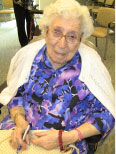The Titanic From Fenwick Family Tales
Mabel Strother and Jim Fenwick were married in Kentucky on April 8th, 1912. They planned to take a month-long honeymoon, touring Europe. They took a train to New York and spent several days with family and friends. Their ship, the Carpathia, set sail for Gibraltar, going on a southern route across the Atlantic Ocean. Meanwhile, the Titanic had left England several days earlier on a more northern route to New York.
Late on the night of April 12th, the Titanic hit an iceberg. The damage was great and the lifeboats were made ready. Some passengers got on the lifeboats but not all, as there were not enough for everyone. The Titanic’s radio operator sent out continuous SOS calls. Many ships heard the call for help, but were unable to go to her aid. The Carpathia’s captain, Arthur Rostron, immediately altered his ship’s course and raced to help. The Titanic was 57 miles away, but Captain Rostron pushed his ship to go faster than it had ever gone. The Carpathia’s passengers were kept in their staterooms by stewards stationed in the corridors.
Blankets and coffee were made ready for the passengers and crew of the Titanic. Captain Rostron steered a straight course through the ice field.
Meanwhile, the passengers in the lifeboats saw the Titanic sink at 2:20 A.M.. They had no idea of where to go. It was freezing cold. They finally saw the lights of the Carpathia coming, and one by one they headed towards it. It took a long time to get all aboard. Mabel Fenwick took many pictures of the Titanic’s survivors with her Kodak camera. Captain Rostron sailed around the spot where the Titanic had gone down, but no one else was found. 1502 people, passengers and crew had perished while only 705 survived.
He turned the ship around and headed back to New York. The ice was a problem and they had very bad weather. They finally reached New York. The Carpathia let the survivors off and stayed in New York to re-fit. The Fenwicks continued on their honeymoon on a different Cunard ship, this time with no interruptions.
by Mary Louise
